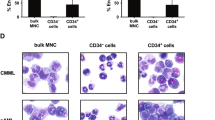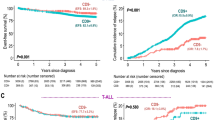Abstract
We quantitatively assessed the expression of cytokine receptors (interleukin-2 receptor (IL-2R), IL-3R, IL-4R, IL-5R, IL-6R, IL-7R, granulocyte-macrophage colony-stimulating factor R (GM-CSFR), G-CSFR, c-fms, c-mpl, c-kit and FLT3) in cells from 211 adults with acute lymphoblastic leukemia (ALL) by flow cytometry and determined their prevalence and clinical significance. Although all cytokine receptors were expressed to various degrees, the levels of IL-3R α-chain (IL-3Rα), IL-2Rα, IL-2Rβ, IL-7Rα, common-Rγ(γc), c-mpl, c-kit and FLT3 exhibited a wide spectrum ⩾2000 sites/cell. Among them, IL-3Rα, IL-2Rα and FLT3 were highly expressed in B-lineage ALL, whereas IL-7Rα, γc and c-kit predominated in T-lineage ALL. Higher levels of IL-3Rα, IL-2Rα, c-kit and FLT3 correlated with the expression of CD13/33. Increased IL-2Rα levels related to the presence of Philadelphia chromosome (Ph), leukocytosis and shorter event-free survival (EFS). C-kit preferred in male. Elevated FLT3 levels correlated with age ⩾60 years. Multivariate analysis in B-lineage ALL revealed only IL-2Rα (P=0.028) and Ph (P=0.020) as independent factors for EFS. These findings suggest that several cytokine receptors associated with certain cellular and clinical features, but IL-2Rα solely had a prognostic value and should be considered as a major prognostic factor for adult ALL that is comparable with Ph.
This is a preview of subscription content, access via your institution
Access options
Subscribe to this journal
Receive 12 print issues and online access
$259.00 per year
only $21.58 per issue
Buy this article
- Purchase on Springer Link
- Instant access to full article PDF
Prices may be subject to local taxes which are calculated during checkout



Similar content being viewed by others
References
Oh H, Gale RP, Zhang MJ, Passweg JR, Ino T, Murakami H et al. Chemotherapy vs HLA-identical sibling bone marrow transcripts for adults with acute lymphoblastic leukemia in first remission. Bone Marrow Transplant 1998; 22: 253–257.
Ribera JM, Oriol A, Bethencourt C, Parody R, Hemendez-Rivas JM, Moreno MJ et al. Comparison of intensive chemotherapy, allogeneic or autologous stem cell transplantation as post remission treatments for adult patients with high-risk acute lymphoblastic leukemia. Results of the PETHEMA ALL-93 trial. Haematologica 2005; 90: 1346–1356.
Thomas X, Boiron J-M, Huguet F, Dombret H, Bradstock K, Vey N et al. Outcome of treatment in adults with acute lymphoblastic leukemia: analysis of the LALA-94 trial. J Clin Oncol 2004; 20: 4075–4086.
Lowengerg B, Touw IP . Hematopoietic growth factors and their receptors in acute leukemia. Blood 1993; 81: 281–292.
Lotem J, Sachs L . Cytokine control of developmental programs in normal hematopoiesis and leukemia. Oncogene 2002; 21: 3284–3294.
Koubek K, Stary J, Kumberova A, Kamova H, Filipec M . Occurrence of cytokine receptors on different lymphoid leukaemia cells. Eur J Haematol 1999; 63: 1–10.
Wu S, Gessner R, von Stockelberg A, Kirchner R, Henze G, Seeger K . Cytokine/cytokine receptor gene expression in childhood acute lymphoblastic leukemia. Cancer 2005; 103: 1054–1063.
Sato N, Caux C, Kitamura T, Watanabe Y, Arai K, Banchereau J et al. Expression and factor-dependent modulation of the interleukin-3 receptor subunit on human hemtopoietic cells. Blood 1993; 82: 752–761.
Watanabe Y, Kitamura T, Hayashida K, Miyajima A . Monoclonal antibody against the common β subunit (βc) of the human interleukin-3 (IL-3), IL-5, and granulocyte-macrophage colony-stimulating factor receptors shows upregulation of βc by IL-1 and tumor necrosis factor-α. Blood 1992; 80: 2215–2220.
Uchiyama T, Broder S, Waldmann TA . A monoclonal antibody (anti-Tac) reactive with activated and functionally mature human T cells. I. Production of anti-Tac monoclonal antibody and distribution of Tac+ cells. J Immunol 1981; 126: 1393–1397.
Tsudo M, Kitamura F, Migasaka M . Characterization of the interleukin-2 receptor βchain using three distinct monoclonal antibodies. Proc Natl Acad Sci USA 1989; 86: 1982–1986.
Shikami M, Miwa H, Nishii K, Takahashi T, Shiku H, Tsutani H et al. Myeloid differentiation antigen and cytokine receptor expression on acute myelocytic leukaemia cells with t(16;21)(p11;q22): frequent expression of CD56 and interleukin-2 receptor α-chain. Br J Haematol 1999; 105: 711–719.
Asou H, Tashiro S, Hamamoto K, Otsuji A, Kita K, Kamada N . Establishment of a human myeloid leukemia cell line (Kasumi-1) with 8;21 chromosomal translocation. Blood 1991; 77: 2031–2036.
Kobayashi T, Tobinai K, Shimoyama M, Mikuni C, Konda S, Kozuru M et al. Long-term follow-up results of adult patients with acute lymphoblastic leukemia or lymphoblastic lymphoma treated with short-term, alternating non-cross-resistant chemotherapy: Japan Clinical Oncology Group Study 8702. Jpn J Clin Oncol 1999; 29: 340–348.
Tanimoto M, Miyawaki S, Ino T, Kyo T, Sakamaki H, Naoe T et al. Response-oriented individualized induction therapy followed by intensive consolidation and maintenance for adult patients with acute lymphoblastic leukemia: the ALL-87 study of the Japan Adult Leukemia Study Group (JALSG). Int J Hematol 1998; 68: 421–429.
Ueda T, Miyawaki S, Asou N, Kuraishi Y, Hiraoka A, Kuriyama K et al. Response-oriented individualized induction therapy with six drugs followed by four courses of intensive consolidation. 1 year maintenance and intensification therapy: the ALL90 study of the Japan Adult Leukemia Study Group. Int J Hematol 1998; 68: 279–289.
Takeuchi J, Kyo T, Naito K, Sao H, Takahashi M, Miyawaki S et al. Induction therapy by frequent administration of doxorubicin with four other drugs, followed by intensive consolidation and maintenance therapy for adult acute lymphoblastic leukemia: the JALSG-ALL93 study. Leukemia 2002; 16: 1259–1266.
Jinnai I, Takeuchi J, Adachi K, Hiraoka A, Kyo T, Fukushima T et al. Strategy for treating adult ALL using new JALSG protocols. Symposium Proceedings of JALSG 10-year Anniversary International Symposium 1999, pp 39–41.
Nakase K, Kita k, Otsuji A, Anazawa H, Hoshino K, Sekine T et al. Diagnostic and clinical importance of interleukin-2 receptor alpha-chain expression on non-T-cell acute leukaemia cells. Br J Haematol 1992; 80: 317–326.
de Totero D, Francia di Celle P, Cignetti A, Foa R . The IL-2 receptor complex: expression and function on normal and leukemic B cells. Leukemia 1995; 9: 1425–1431.
Paietta E, Racevskis J, Neuberg D, Rowe JM, Goldstone AH, Wiernik PH . Expression of CD25 (interleukin-2 receptor α-chain) in adult acute lymphoblastic leukemia predicts for the presence of BCR/ABL fusion transcripts: results of a preliminary laboratory analysis of ECOG/MRC intergroup study E2993. Leukemia 1997; 11: 1887–1890.
Foa R, Caretto P, Fierro MT, Bonferroni M, Cardona S, Guarini A et al. Interleukin 2 does not promote the in vitro and in vivo proliferation and growth of human acute leukaemia cells of myeloid and lymphoid origin. Br J Haematol 1990; 75: 34–40.
Nakase K, Kita K, Kageyama S, Tsuji K, Miyanishi E, Miwa H et al. Clinical importance of interleukin-2 receptor α-chain expression in acute leukemia. Cancer Detect Prev 1997; 21: 273–279.
Moon Y, Kim Y, Kim K, Lim J, Kang CS, Kim WI et al. Plasma soluble interleukin-2 receptor (sIL-2R) levels in patients with acute leukemia. Ann Clin Lab Sci 2004; 34: 410–415.
Rubin LA, Jay G, Nelson DL . The released interleukin-2 receptor binds interleukin-2 efficiently. J Immunol 1986; 137: 3841–3844.
Pui C-H, Ip SH, Iflah S, Behm FG, Grose BH, Dodge RK et al. Serum interleukin-2 receptor levels in childhood acute lymphoblastic leukemia. Blood 1988; 71: 1135–1137.
Zoru U, Dallmann I, Grosse J, Kirchner H, Poliwoda H, Atzpodien J . Soluble interleukin 2 receptors abrogate IL-2 induced activation of peripheral mononuclear cells. Cytokine 1994; 6: 358–364.
Paietta E, Nelson DL, Andersen J, Dutcher JP, Wiernik PH . Levels of soluble interleukin-2 receptors are predictive of response in patients with interleukin-2 and lymphokine-activated killer cells. Med Oncol 1995; 12: 121–124.
Testa U, Riccioni R, Militi S, Coccia E, Stellacci E, Samoggia P et al. Elevated expression of IL-3Rα in acute myelogenous leukemia is associated with enhanced blast proliferation, increased cellularity, and poor prognosis. Blood 2002; 100: 2980–2988.
Tsuura Y, Suzuki T, Honma K, Sano M . Expression of c-kit ptotein in proliferative lesions of human breast: sexual difference and close association with phosphotyrosine status. J Cancer Res Clin Oncol 2002; 128: 239–246.
Nishii K, Kita K, Miwa H, Kawakami K, Nakase K, Masuya M et al. c-kit gene expression in CD7-positive acute lymphoblastc leukemia: close correlation with expression of myeloid-associated antigen CD13. Leukemia 1992; 6: 662–668.
Carow CE, Levenstein M, Kaufmann SH, Chen J, Amin S, Rockwell P et al. Expression of the hematopoietic growth factor receptor FLT3 (STK-1/Flk2) in human leukemias. Blood 1996; 87: 1089–1096.
Drexler HG . Expression of FLT3 receptor and response to FLT3 ligand by leukemic cells. Leukemia 1996; 10: 588–599.
Kiyoi H, Naoe T, Nakano Y, Yokota S, Minami S, Miyawaki S et al. Prognostic implication of FLT3 and N-RAS gene mutations in acute myeloid leukemia. Blood 1999; 93: 3074–3080.
Frohling S, Schlenk RF, Breitruck J, Benner A, Kreitmeler S, Tobis K et al. Prognostic significance of activating FLT3 mutations in younger adults (16 to 60 years) with acute myeloid leukemia and normal cytogenetics: a study of the AML study group Ulm. Blood 2002; 100: 4372–4380.
Ozeki K, Kiyoi H, Hirose Y, Iwai M, Ninomiya M, Kodera Y et al. Biologic and clinical significance of the FLT3 transcript level in acute myeloid leukemia. Blood 2004; 103: 1901–1908.
Yanada M, Takeuchi J, Sugiura I, Akiyama H, Usui N, Yagasaki F et al. High complete remission rate and promising outcome by combination of Imatinib and chemotherapy for newly diagnosed BCR-ABL-positive acute lymphoblastic leukemia: a phase I study by the Japan adult leukemia study group. J Clin Oncol 2006; 24: 460–466.
Waldmann TA, White JD, Carrasquillo JA, Raynolds JC, Paik CH, Gansow OA et al. Radioimmunotherapy of interleukin-2r α-expressing adult T-cell leukemia with Yttrium-90-labeled anti-Tac. Blood 1995; 86: 4063–4075.
Koon HB, Severy P, Hagg DS, Butler K, Hill T, Jones AG et al. Antileukemic effect of daclizumab in CD25 high-expressing leukemias and impact of tumor burden on antibody dosing. Leuk Res 2006; 30: 190–203.
Acknowledgements
We gratefully acknowledge Drs T Uchiyama, M Tsudo, T Kitamura, R Ueda and E Tatsumi for supplying mAbs. We also thank Drs T Kobayashi, S Kageyama, H Anazawa and M Masuya (Mie University, Tsu, Japan), K Kawakami (Suzuka Chuo Hospital, Suzuka, Japan), K Oka (Suzuka Kaisei Hospital, Suzuka, Japan), T Sekine (Matsusaka Chuo Hospital, Matsusaka, Japan), A Otsuji (Matsusaka Municipal Hospital, Matsusaka, Japan), K Tsuji and S Tamaki (Yamada Red Cross Hospital, Ise, Japan), and N Kamada (Research Institute for Nuclear Medicine and Biology, Hiroshima, Japan) for important information. This work was supported in part by Grants-in-Aid for Scientific Research from the Ministry of Education, Science and Culture, and Grants-in-Aid for Cancer Research from the Ministry of Health and Welfare of Japan.
Author information
Authors and Affiliations
Corresponding author
Rights and permissions
About this article
Cite this article
Nakase, K., Kita, K., Miwa, H. et al. Clinical and prognostic significance of cytokine receptor expression in adult acute lymphoblastic leukemia: interleukin-2 receptor α-chain predicts a poor prognosis. Leukemia 21, 326–332 (2007). https://doi.org/10.1038/sj.leu.2404497
Received:
Revised:
Accepted:
Published:
Issue Date:
DOI: https://doi.org/10.1038/sj.leu.2404497
Keywords
This article is cited by
-
Recent updates for antibody therapy for acute lymphoblastic leukemia
Experimental Hematology & Oncology (2020)
-
Bone marrow T helper cells with a Th1 phenotype induce activation and proliferation of leukemic cells in precursor B acute lymphoblastic leukemia patients
Oncogene (2019)
-
Pediatric precursor B acute lymphoblastic leukemia: are T helper cells the missing link in the infectious etiology theory?
Molecular and Cellular Pediatrics (2017)
-
Immunoregulation by IL-7R-targeting antibody-drug conjugates: overcoming steroid-resistance in cancer and autoimmune disease
Scientific Reports (2017)
-
Expression of CD25 antigen on CD34+ cells is an independent predictor of outcome in late-stage MDS patients treated with azacitidine
Blood Cancer Journal (2014)



